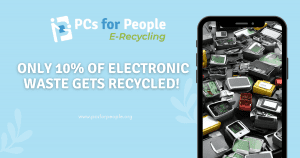 In today’s tech-driven world, electronic devices are crucial in our daily lives. From smartphones to laptops, we rely heavily on these gadgets for communication, work, and entertainment. However, with the constant evolution of technology comes a concerning side effect: electronic waste, or e-waste. E-waste comprises discarded electronic devices, and it’s a growing problem worldwide. Unfortunately, despite increased awareness about the importance of recycling, only about 10% of electronic waste gets recycled globally. This statistic highlights a significant environmental challenge that demands our attention and action.
In today’s tech-driven world, electronic devices are crucial in our daily lives. From smartphones to laptops, we rely heavily on these gadgets for communication, work, and entertainment. However, with the constant evolution of technology comes a concerning side effect: electronic waste, or e-waste. E-waste comprises discarded electronic devices, and it’s a growing problem worldwide. Unfortunately, despite increased awareness about the importance of recycling, only about 10% of electronic waste gets recycled globally. This statistic highlights a significant environmental challenge that demands our attention and action.
The low recycling rate of electronic waste can be attributed to various factors, including inadequate infrastructure, lack of awareness, and the complex nature of e-waste itself. Unlike traditional waste, electronic devices contain valuable materials such as gold, silver, and copper, making them desirable for recycling. However, extracting these materials in an environmentally friendly and cost-effective manner poses challenges.
One of the primary obstacles to e-waste recycling is the need for more convenient disposal options for consumers. Many people do not know where or how to recycle their old electronic devices properly. As a result, these gadgets often end up in landfills, contributing to environmental pollution and posing health risks due to the release of toxic substances.
Moreover, the recycling process for electronic waste requires specialized facilities and equipment, which are only sometimes readily available. In some regions, recycling facilities may be scarce or located far from populated areas, making it impractical for consumers to recycle their e-waste. Additionally, the lack of standardized recycling practices and regulations further complicates the recycling process.
However, despite these challenges, there is hope on the horizon. Governments, businesses, and organizations like PCs for People increasingly recognize the importance of addressing the e-waste problem and are taking steps to improve recycling infrastructure and raise awareness.
Initiatives such as electronic take-back programs, where manufacturers are responsible for recycling their products at the end of their life cycle, are gaining traction. Furthermore, advancements in recycling technologies, such as automated dismantling and material recovery processes, are making e-waste recycling more efficient and cost-effective.
Individuals can also play a crucial role in combating the e-waste epidemic by adopting responsible consumption habits and recycling practices. Instead of discarding old electronic devices, consider donating them to charities or recycling centers like PCs for People. Additionally, educate yourself about e-waste recycling options available in your area and try properly disposing of your electronic gadgets.
In conclusion, the low recycling rate of electronic waste is a pressing environmental issue that requires collective action. By improving recycling infrastructure, raising awareness, and promoting responsible consumption, we can work towards a more sustainable future where electronic waste is no longer a burden on our planet. Let’s take the necessary steps today to ensure a cleaner and healthier tomorrow for future generations.



